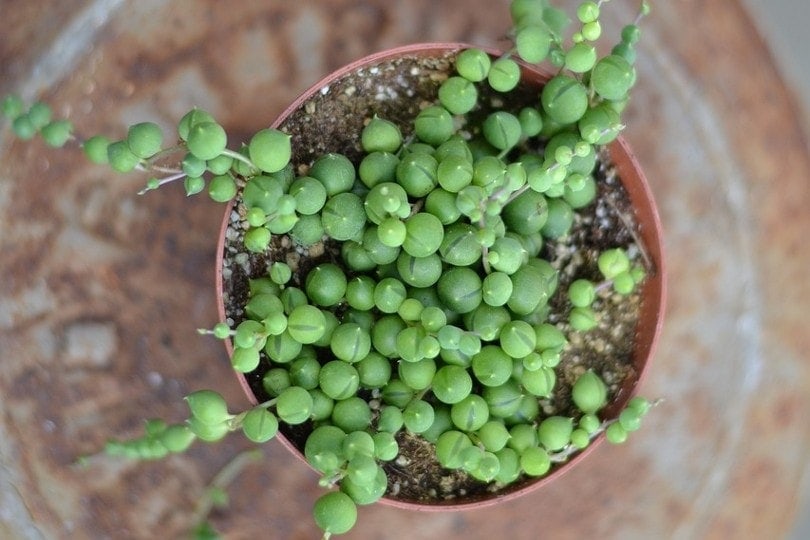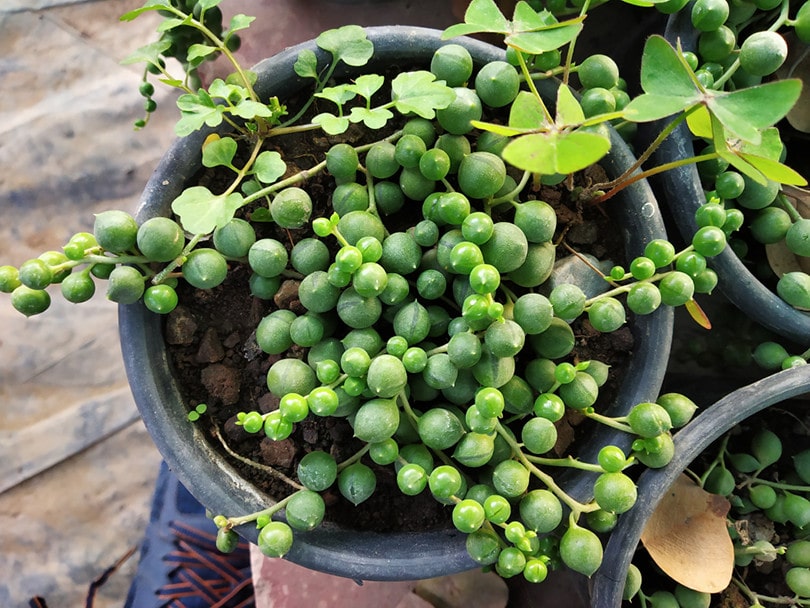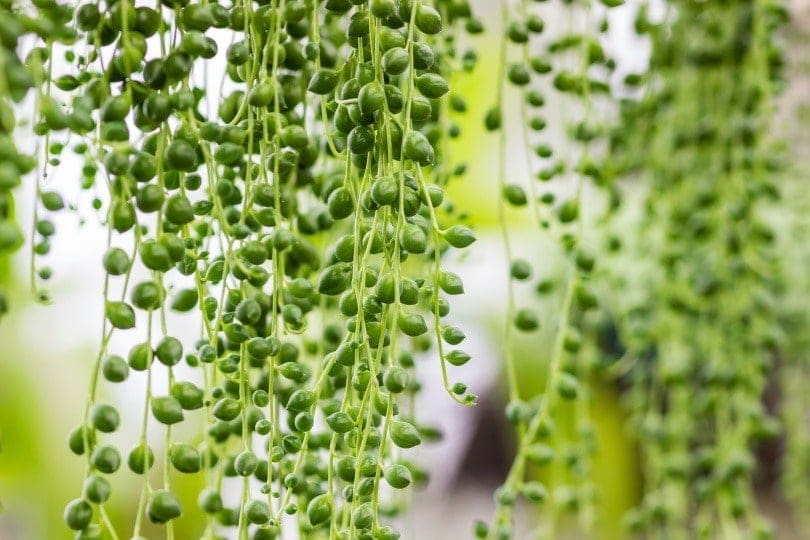How Much and How Often Should You Water String of Pearls?
-

- Last updated:

The string of pearls is a succulent plant variety that is highly coveted by gardeners because of its beautiful pearl-shaped leaves that look amazing when growing in a hanging basket. However, the watering requirement for this stunning plant is one of the biggest challenges that gardeners face. These plants are overly sensitive to overwatering and underwatering, and, thus, it is crucial to get it right.
Keep in mind that this plant is highly drought resistant and, as such, should only be watered when the soil around the roots is completely dry.
This article will discuss everything you need to know about watering string of pearls. Continue reading to learn more.
How Much to Water String of Pearls
Like other succulent plant varieties, the string of pearls is well adapted to thrive in the hot desert climate. The plant’s leaves are shaped like pearls to minimize the surface exposed to the sun for evaporation and maximize the leaves’ water retention capacity. Since these plants are adapted to hot and dry conditions, they are susceptible to overwatering.
If you want to successfully grow a string of pearls plant in your home, try mimicking the watering conditions of their native arid environment by giving them just enough water to survive. Therefore, you should only water your plants after 14 days. This is usually the time it takes for the potting mix to dry out.
Remember, it is vital to thoroughly water your plant until every root strand gets its fair share of water. But you need to ensure there are enough drainage holes for excess water to flow out of the pot quickly.

Factors Affecting Watering Requirements in String of Pearls
The watering schedule will also depend on external factors such as temperature, season, and light, among others. It will depend upon the time taken by the potting mix to completely dry. This will hinge on a range of factors. So, you will need to adjust your watering requirement based on these conditions.
1. Light
For adequate development, these plants need at least 6–8 hours of exposure to direct and indirect light daily. With enough light, your string of pearls will need more water because the soil will dry up more quickly. However, if growing your plants in low-light conditions, they will not require as much water because the soil takes longer to dry.
2. Temperature
Temperature changes also affect the watering requirements of the string of pearls. These plants thrive in temperatures between 50°F –60°F during colder months. But during warmer months, the plants need temperatures above 70°F. When temperatures are high, you need more water and vice versa.
3. Humidity
Humidity may not be that big of a factor when it comes to watering requirements of the string of pearls plant, but drastic changes in humidity will have a bearing on the plant’s watering needs. Normally, these plants do well in humidity levels that do not drop below 50%. If the level goes higher, the need for water decreases because the soil takes longer to dry.
4. Potting Mix
The potting mix is an important consideration because gardeners usually refer to water drainage from the potting mix to determine the watering schedule. Since these plants are succulents, they thrive in a cactus potting mix. Regular potting soil is not recommended because it tends to be heavy and does not drain well. These plants need well-draining soils that don’t take long to dry out.
5. Size of the Pot
If you grow your string of pearls in a large pot, chances are high that you will need more water and soil. The watering frequency will also be more compared to smaller pots. Sure, having a bigger pot will allow the plant roots to grow freely and spread further, but it also increases the risk of overwatering. In contrast, smaller pots reduce the chances of root rot from too much water.
How to Tell Your String of Pearls Plant Needs Water
Now that you know the string of pearls plant doesn’t require frequent watering like other indoor plants, how can you tell when it needs water? Well, different plants have different tell-tale signs that they need water. Some might droop, while others shrivel and turn yellow. In the string of pearls indications that your plants need water include:

Shriveling Pearl Leaves
As earlier mentioned, the leaves of these plants are specially adapted to help them thrive in a desert environment. When the plant doesn’t receive any water, they shrivel. Therefore, you need to keep inspecting the pearl leaves for any signs of shriveling, which shows that the plant is thirsty.
Browning Leaves
If you do not water your plant for a very long time until the soil becomes bone dry, it will become water resistant. So, the next time you water the plant, the soil will be too dry to absorb it, depriving your roots of water. This kind of erratic watering forces the plants to use up all the water stored in the pearls and causes the leaves to turn brown.
A Sticky Texture
According to many gardeners, the plant tends to have a sticky texture when dehydrated. So, if your plant feels sticky to the touch, it’s probably time you watered it.
How Often to Water String of Pearls
Since these plants are drought tolerant, they do not need a lot of water as they develop. Therefore, there is no fixed watering schedule. The watering routine will hinge on external factors such as seasons and the climate of your locality.
The best way to determine the appropriate time to water your plant is to feel for the moisture content of the potting mix at the bottom of your growing pot to determine if the soil is moist or completely dry.
Watering in Summer
In the summer months, the sun shines bright, the weather is warmer, and the soil dries up more quickly. So, the frequency of watering will be higher in summer. Yet, you should avoid adopting a fixed watering routine because you could easily overwater it. If unsure how much water your plant will require, start by availing a small amount and see the reaction. Then, increase the watering as required.
Watering in Winter
In the cold winter months when the sun rays are mild, it takes longer for the soil to completely dry out. Also, the string of pearls is usually dormant during winter. Therefore, the watering requirements of the plant will also be reduced to every 2–3 or at least once a month.
How to Properly Water String of Pearls
- Water the plant generously until excess water starts to drain out through the drainage holes at the bottom end of the growing pot. This allows water to reach all parts of the root.
- Do not water your plants as frequently as you desire because it can promote root rot in your string of pearls.
- Always start by watering the base of the plant. If you water from the top, you risk water settling on the leaves. This usually limits the plant’s ability for transpiration.
- It’s not advisable to water at night because the soil will remain moisture saturated for too long and can cause root rot. However, watering in the morning will balance the moisture content in the soil and use water more efficiently.
- The best way to water these indoor plants is through the soak-and-dry method. It involves soaking the plant after the soil is completely dry. This method mimics the native climate of the plants where heavy rainfall is usually followed by drought.
- Ensure that you use a succulent potting mix when growing your string of pearls. Succulent soil is coarse and porous enough to allow excess water to drain well.
- Rainwater is the best when it comes to watering succulents like the string of pearls. Collect as much as you can during the rainy season for use throughout the year. If rainwater is unavailable, consider using distilled water because it doesn’t have as many chemical additives that could harm the plant.
Conclusion
The string of pearls is a beautiful indoor plant and is ideal for beginners because it can survive with minimal care. However, the most vital aspect of its care is to understand the plant’s watering requirements. The amount and frequency you water this plant will depend on factors such as soil, humidity, temperature, season, climate, etc.
The best way to go about it is to check the soil’s moisture content to ensure that it is dry before watering. Fortunately, with our tips, and watering schedule, your plant will blossom and add to the aesthetic appearance of your indoor and outdoor spaces.
- https://www.ecolandscaping.org/08/developing-healthy-landscapes/ecological-landscaping-101/rainwater-for-gardens-why-plants-love-rainwater-best/
- https://succulentplantcare.com/why-are-my-string-of-pearls-plant-shriveling/
- https://succulentplantcare.com/how-to-save-a-dying-string-of-pearls-plant/
- https://simplifyplants.com/how-much-light-does-a-string-of-pearls-need/
- https://succulentsbox.com/blogs/blog/common-problems-of-string-of-pearls-and-how-to-fix-them
Featured Image Credit: Veronicatxoxo, Pixabay
Contents

